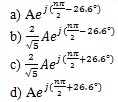Test: LTI System Frequency Characteristics - Electronics and Communication Engineering (ECE) MCQ
10 Questions MCQ Test Digital Signal Processing - Test: LTI System Frequency Characteristics
If x(n)=Aejωn is the input of an LTI system and h(n) is the response of the system, then what is the output y(n) of the system?
If the system gives an output y(n)=H(ω)x(n) with x(n)= Aejωnas input signal, then x(n) is said to be Eigen function of the system.
| 1 Crore+ students have signed up on EduRev. Have you? Download the App |
What is the output sequence of the system with impulse response h(n)=(1/2)nu(n) when the input of the system is the complex exponential sequence x(n)=Aejnπ/2?

If the Eigen function of an LTI system is x(n)= Aejnπ and the impulse response of the system is h(n)=(1/2)nu(n), then what is the Eigen value of the system?
If h(n) is the real valued impulse response sequence of an LTI system, then what is the imaginary part of Fourier transform of the impulse response?
If h(n) is the real valued impulse response sequence of an LTI system, then what is the phase of H(ω) in terms of HR(ω) and HI(ω)?
What is the magnitude of H(ω) for the three point moving average system whose output is given by y(n)=1/3[x(n+1)+x(n)+x(n-1)]?
What is the magnitude of the frequency response of the system described by the difference equation y(n)=ay(n-1)+bx(n), 0<a<1?
If an LTI system is described by the difference equation y(n)=ay(n-1)+bx(n), 0 < a < 1, then what is the parameter ‘b’ so that the maximum value of | H(ω)| is unity?
If an LTI system is described by the difference equation y(n)=ay(n-1)+bx(n), 0
|
3 videos|50 docs|54 tests
|
|
3 videos|50 docs|54 tests
|

















